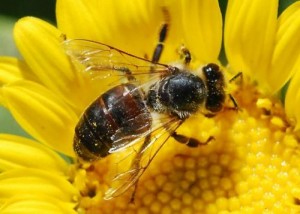New Zealand has a love affair with bees. Not only are we a significant producer and consumer of honey and its derivative products, we have a close affinity with bees that translates into a type of public fascination.
 Stories about bees always rate well, I’m told by people in the media. Witness Radio New Zealand’s This Way Up presenter Simon Morton’s popular series on his own bee-keeping experiment.
Stories about bees always rate well, I’m told by people in the media. Witness Radio New Zealand’s This Way Up presenter Simon Morton’s popular series on his own bee-keeping experiment.
There’s a perception that bees are under threat worldwide and that due to their importance to the process of pollination, this has potentially devastating consequences for the natural ecosystem – and the crops we depend on.
But the Economist has been looking at one area where there is currently a glut of honey bees – California. As the Economist explains puts the flourishing bee population down to the side effects of the economic crisis:
:This year’s Californian bee glut, then, has been caused by a mixture of rising supply meeting falling demand. The price of almonds dropped by 30% between August and December last year, as people had less money in their pockets. That has caused growers to cut costs, and therefore hire fewer hives.
“There is also a drought in the region, and many farmers are unlikely to receive enough water to go ahead with the harvest. Meanwhile, the recent high prices for pollination contracts made it look worthwhile fattening bees up with supplements over the winter. That may help explain why there have been fewer colony collapses.”
While acknowledging the trends towards bees vanishing in record numbers, the Economist goes on to say:
“No one has shown that colonies of wild bees are collapsing any more frequently than they used to. And while it is true that many species of butterflies, moths, birds, bats and other pollinators are in retreat, their problems are far more likely to mirror broader declines in biodiversity that are the result of well-known phenomena such as habitat loss and the intensification of agriculture.
“Troubling though this loss of diversity is, it does not necessarily translate into a decline in the amount of pollination going on.”
Last year the Science Media Centre followed up news that the United Nations was to fund international research into the reasons behind declines in bee populations around the world by asking local scientists for their take on the worrying trend.
Mark Goodwin of the Honeybee Research Institute at HortResearch (now Plant & Food Research) pinned the blame on diseases affecting honey bees, such as the varroa mite, which has devastated bee populations in parts of New Zealand.
“To conserve bees, we need to find solutions to their diseases, and a sustainable method of controlling the varroa mite,” he said.
Others were more cautious in their analysis of the decline:
“Whether the 20,000 species of bees known world-wide are under real threat is difficult to determine,” said entomologist, Barry Donovan.
Some good comments listed at the bottom of the Economist piece, raise other good points:
Says Fred Schumacher: “This article is about commercial honeybees, but other bees, especially native bumblebees have been hit hard by a population crash. I like to photograph bees, so I’m more sensitive to changes in their population and type, and this past year, here in Minnesota, both in the south, where I am for 9 months, and in the north, where I am during the summer, bumblebee populations crashed. I would say it was a 90% die off. The population started recovering modestly in early fall, so I’m anxiously awaiting to see what the coming growing season will bring.”
Sentiments I’m sure that would be reflected by New Zealanders paying attention to their surrounding environment. The problem of bee decline is one that needs further and urgent attention, the stakes are too high to treat it the same way we are broader declines in biodiversity.